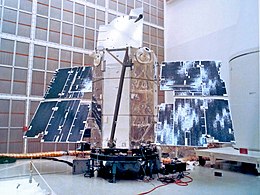 Technicians in a clean room at NASA’s Kennedy Space Center in Cape Canaveral, Florida, check out the Orbiting Astronomical Observatory 2 before the mission’s Dec. 7, 1968, launch. | |
| Names | OAO-A2, OAO2 |
|---|---|
| Mission type | Astronomy |
| Operator | NASA |
| COSPAR ID | 1968-110A |
| SATCAT no. | 3597 |
| Spacecraft properties | |
| Manufacturer | Grumman |
| Dry mass | 2,012 kilograms (4,436 lb) |
| Start of mission | |
| Launch date | 7 December 1968, 08:40:09 UTC |
| Rocket | Atlas SLV-3C Centaur-D |
| Launch site | Cape Canaveral LC-36B |
| End of mission | |
| Disposal | Telescope issues |
| Deactivated | February 1973[1] |
| Orbital parameters | |
| Reference system | Geocentric |
| Regime | Low Earth |
| Perigee altitude | 768 kilometres (477 mi) |
| Apogee altitude | 777 kilometres (483 mi) |
| Inclination | 35.0 degrees |
| Period | 100.30 minutes |
| Epoch | 6 January 1969[2] |
The Orbiting Astronomical Observatory 2 (OAO-2, nicknamed Stargazer) was the first successful space telescope (first space telescope being OAO-1, which failed to operate once in orbit), launched on December 7, 1968.[3] An Atlas-Centaur rocket launched it into a nearly circular 750-kilometre (470 mi) altitude Earth orbit.[4] Data was collected in ultraviolet on many sources including comets, planets, and galaxies.[3][5] It had two major instrument sets facing in opposite directions; the Smithsonian Astrophysical Observatory (SAO) and the Wisconsin Experiment Package (WEP).[5] One discovery was large halos of hydrogen gas around comets,[5] and it also observed Nova Serpentis, which was a nova discovered in 1970.[3]
- ^ "NASA's First Stellar Observatory, OAO 2, Turns 50". NASA. 11 December 2018. Retrieved 19 March 2023.
- ^ McDowell, Jonathan. "Satellite Catalog". Jonathan's Space Page. Retrieved 12 October 2013.
- ^ a b c Joseph A. Angelo (2014). Spacecraft for Astronomy. Infobase Publishing. p. 20. ISBN 978-1-4381-0896-4.
- ^ Gunter – OAO-2
- ^ a b c Orbiting Astronomical Observatory OAO-2